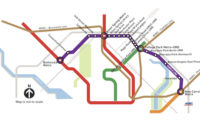An aggressive effort to overhaul the aging Metro system in Washington, D.C., is producing results as it nears the one-year mark, with more than 28,000 cross-ties and nearly two miles of grout pads now replaced.
The 117-mile system has undergone a series of power-system fires, derailments and other disruptions. The causes range from a lack of a dedicated funding source to a philosophy among former Washington Metropolitan Transportation Agency (WMATA) administrators to prioritize operations over upkeep.
Paul J. Wiedefeld, a 30-year transportation veteran appointed in November 2015 as WMATA’s CEO and general manager, ordered a daylong system shutdown last May to repair third-rail jumper cables. The cornerstone of Wiedefeld’s efforts is an accelerated maintenance program called SafeTrack, which launched in mid-2016. WMATA hopes to cram three years’ worth of repairs into 12 months by augmenting the maintenance program during weekends and non-operational hours with 16 “surges”—extended shutdowns of specific sections.
Laura Mason, a former Bechtel executive hired in June to oversee SafeTrack, calls the schedule “relentless” but adds that, so far, she is pleased with the progress. Mason cites a 10-mile section of the Orange Line in Virginia that was brought up to date in four surges, totaling 90 days. A weekend-only approach would have accomplished only half as much, she notes.
WMATA augmented in-house staff with existing maintenance contractors. Mason says the contracts were modified to increase value. “The contractors are there to support our workforce,” she says.
The Federal Transit Administration estimates the program will cost nearly $119 million, almost double Wiedefeld’s original estimate. “Our focus is on being more efficient with what we’re spending,” Mason says, “not to limit its scope.”
Metro’s challenges won’t end with the scheduled conclusion of SafeTrack in June. WMATA’s proposed $3.1-billion operating budget for FY18 has been criticized for planned service cutbacks in order to support the planned return to a preventive maintenance regimen. Also, Wiedefeld has called on Virginia, Maryland and the District of Columbia to increase their annual subsidies by as much as $100 million. Otherwise, according to a recent consultants’ report presented to the WMATA board of directors, Metro’s climbing expenses could put the agency in a $1.1 billion deficit by 2020.
Silver Lining
As Metro sorts out its existing infrastructure, the system’s next expansion is taking shape. The $2.8-billion second phase of the Silver Line will bring Metro to Washington Dulles International Airport and some suburbs in northern Virginia. As with phase one, the Silver Line is being led by the Washington Metropolitan Airports Authority (MWAA), mostly within the right-of-way of the agency’s Dulles Access and Toll Road. Once commissioned, operation of the Silver Line will be turned over to WMATA.
Capital Rail Constructors, a joint venture of Clark Construction Group LLC and Kiewit Infrastructure South Co., is leading the design-build work on the 11.4-mile, six-station project.
As of January, phase two had passed the halfway mark, with all line segments and stations underway, reports Charles Stark, MWAA project executive. Some of the most visible work is taking place at the airport, where seven of eight cast-in-place straddle bents are complete. The bents will carry the aerial guideway over roadways to the aerial station platform.
Stark notes that, east of the airport, harder-than-expected rock delayed the station’s foundation work and utility tunnels. “The contractor first tried jack-and-bore, then directional drilling, but the bits kept getting stuck,” he says. “They were forced to use jackhammers as a last resort.”
Although the troublesome subsurface conditions complicated work at a railyard, requiring the use of blasting, Stark doesn’t project any cost overruns on the way to the scheduled 2018 opening. “I think we’ll come in good,” he says.




Post a comment to this article
Report Abusive Comment